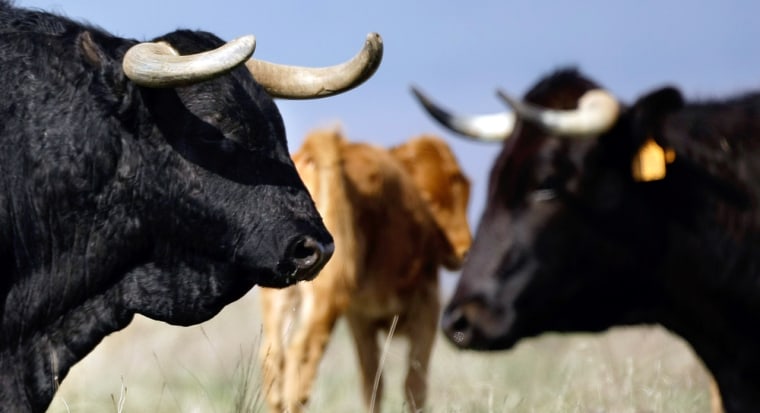Alcalde, a hulking black bull, is quite the stud. He sires up to 40 calves a year, most of them top-grade fighters, even though in human terms he'd be almost 80 years old and is nearing the end of his life.
Victoriano del Rio, a fifth-generation breeder of fighting bulls, cringes at the thought of losing a creature with such good genes. So he is going to clone him — an unprecedented marriage of modern technology and the Spanish-speaking world's ancient, beloved pastime.
"I am extremely fond of this bull," del Rio said at his ranch in this town outside Madrid, watching 16-year-old Alcalde graze with some of his latest offspring — mere toys next to their prolific, half-ton father. "He has given us tremendous satisfaction."
Del Rio is not alone in the adventure. Rancher Jose Manuel Fernandez in Mexico plans to replicate Zalamero, another revered, aging bull that achieved the rare feat of dodging death in the ring: In 1994 Zalamero put up such a relentless fight one autumn day that judges spared his life. Since then Zalamero, too, has been a priceless stud.
Fernandez is so bullish on cloning he envisions a future in which an afternoon at the arena — usually three matadors taking on two bulls each — might involve six genetically identical twins created from the same beast.
"What I am looking for is a path toward innovation in bullfighting," Fernandez said from Mexico City. "We are trying to give the show greater quality."
If all goes as planned, Zalamero II — or several of them, because Fernandez is trying for four or five — will be born in November or December of this year. Alcalde's clone would be born in May or June of 2009.
The Dolly technique
Both breeders have hired ViaGen, a cloning company based in Austin, Texas, to do the job. The technique is essentially the same one used in 1996 to copy the sheep Dolly, the world's first cloned mammal.
It works like this: the nucleus of a somatic cell from the bull (any cell that is not a sperm cell) is inserted into a cow's egg cell that has been stripped of its own nucleus. The egg undergoes electrical and chemical stimulation to make it divide and grow into an embryo. This is then implanted in a surrogate cow to be carried to term.
ViaGen spokesman Ben Carlson confirmed the orders from del Rio and Fernandez, but would not comment on pregnancies or expected birth dates. Carlson said the breeders would pay standard cattle cloning prices: $17,500 for the first calf, $15,000 for the second, $12,500 for the third and $10,000 for the fourth and beyond.
ViaGen has cloned about 300 mammals, including show pigs, rodeo horses and bucking broncos, since its founding in 2002. But this is the world's first go at cloning the breed that takes on matadors in the deadly minuet of bullfighting.
"It is a new field that is opening up before us," said Eduardo Miura, veteran breeder of a line of Spanish bulls so fierce the very word Miura has become part of the language: to act like a Miura is to become furious. He said breeders in Spain are generally supportive of del Rio's cloning plans.
But question marks abound. It's one thing to pass on a carbon copy of a fighting or stud bull's DNA, quite another to expect the new animal to mimic its template.
Only as much as 40 percent of an animal's behavior is attributable to its genes, said Javier Canon, a geneticist at Madrid's Complutense University who specializes in fighting bulls. External factors account for the rest.
And even if the sons of a great fighting bull were always great fighting bulls themselves there are much cheaper and more effective ways to harvest those valuable genes, such as using the father's semen for artificial insemination.
"If you ask me about this project from a technical point of view, in terms of genetic progress it serves no purpose whatsoever," Canon said.
Hit-and-miss process
Even in its traditional mode, bull breeding is a slow, hit-or-miss business. Studs are crossed with cows carefully selected for feistiness through simulated fights in the ring, albeit without bloodshed. Then the rancher has to wait a few years for the resulting bull to grow up, and see if it has the right stuff.
"Theoretically, two plus two are four. In this, when the time comes, it might not be four, but rather minus three. The results are very elastic," Miura said from his ranch outside Seville. "Time will tell if Victoriano is right."
"Indeed, it is an experiment," del Rio said of his cloning project. "We are going to investigate. Investigation always carries with it the possibility that you are wrong."
A ViaGen team will come to Spain in a few weeks to collect skin samples from Alcalde — the name means 'mayor' — and take them back to Texas to start preparing embryos. Fernandez's endeavor is at a more advanced stage; he said the embryos are already growing and will be implanted in cows this month in Mexico. Viagen is also in talks with other breeders in Spain.
Fernandez says about 20 percent of Mexican breeders dismiss his project as unworkable, arguing the clones would not be on par with Zalamero. At age 18 — ancient for a bull — yet another calf of his was born recently.
Fernandez says wait and see.
"I imagine I am building a bridge, and they tell me, 'hey, that bridge is not going to work. So I say let me finish, and if I cross the bridge, then it is OK. It held. If it doesn't hold, then you were right."
"At least we are trying," Fernandez said of himself and del Rio. "We are not waiting around to see someone else do it. We are trying."
